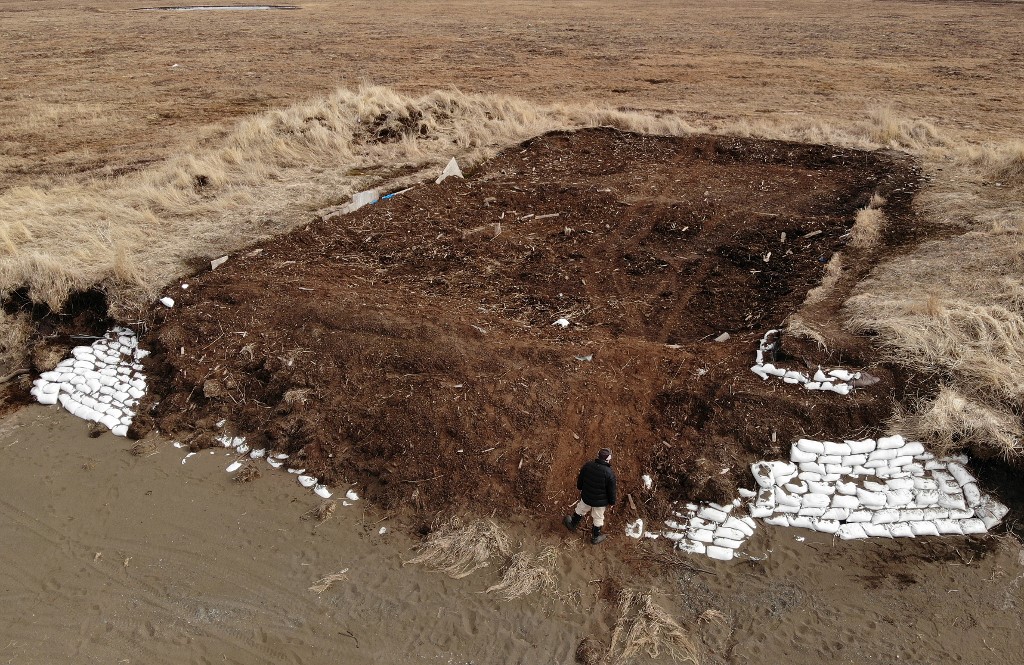
by Jocelyne Zablit
Agence France Presse
QUINHAGAK, United States (AFP) — The first artifact — a wooden mask — was discovered in 2007 by a child who stumbled upon it while playing on the beach near his home in Quinhagak, a village in western Alaska that sits by the Bering Sea.
Over the following months, hundreds of similar objects — baskets, finely carved harpoon shafts, lip plugs, wooden dolls, ivory tattoo needles — emerged from the earth as melting permafrost and erosion driven by climate change revealed a Yupik Eskimo settlement dating back to the 1600s.
Today, more than a decade after the first find, an extraordinary collection of some 100,000 prehistoric Yupik artifacts — the largest such collection in the world — sits in a small newly opened museum in Quinhagak, home to an indigenous community of about 700 people.
“This is by far the highlight of everything I’ve ever excavated in my 40-year-career — and I’ve worked on some pretty spectacular sites,” said Rick Knecht, an archaeologist with the University of Aberdeen in Scotland.
For the past 10 years Knecht has led a team racing to save as many items as possible at the excavation site about three miles (4.8 kilometers) from Quinhagak and dubbed Nunalleq, which means Old Village in the Yupik language.
“Almost everything we know about Yupik prehistory comes from this site,” said Knecht, an affable man with a grizzled beard, as he surveyed the area recently with an AFP team.
“If we’d lost it, the people here would have lost their past and a tangible link to that past, which would have been an unbelievable tragedy.”
– Race against the elements –
But while Knecht marvels at the trove of artifacts discovered at Nunalleq and the clues these objects have provided to traditional Yupik culture, he is also horrified that similar sites across Alaska are probably disappearing as the frozen ground that has preserved them for centuries thaws and erosion sweeps them away.
“As the permafrost melts, you can see that the soil liquefies. It’s like a box of ice cream,” Knecht said, pointing to the gooey mud along the fast-eroding shoreline in Quinhagak and large clumps of earth ready to topple into the sea.
“We’ve only saved this one site but tens of thousands like it are being lost right now while we’re talking because of climate change,” he said. “In some places in the Arctic, the coastline has gone back more than a mile.
“And since I’ve been here in Quinhagak, it’s gone back 10 to 20 meters in merely 10 years.”
Knecht became involved with the excavation project in 2009 after Warren Jones, a village leader, contacted him, desperate to salvage what remains of his people’s past.
Based on carbon dating of organic material at Nunalleq, experts believe the site dates back to a time historians call the Bow and Arrow Wars, when Yupik communities were engaged in fierce warfare and before Russian explorers discovered Alaska in the early 1800s.
“This was our heritage and we had to preserve it,” recalls Jones. “We couldn’t let it get lost at sea.”
But getting village elders who believe ancestral sites should not be disturbed to agree was no easy task.
“It took Warren Jones two years to talk the village, person by person, into allowing an archaeological project,” Knecht said. “They thought long and hard about it and some of the elders who were reluctant are now our strongest supporters.”
– ‘Cultural tragedy’ –
Many village residents now volunteer every summer to join Knecht and his crew of fellow archaeologists and students as they sift through the earth to save what they can.
“You get this terrible feeling of working against time and you realize the full scope of the cultural tragedy that is part of climate change,” said Knecht. “It’s grim, it really is grim. It’s a horror show.
“For every beautifully preserved mask lifted out of the ground, there are thousands falling to the sea in other still undiscovered sites that no one will ever see.”
But against the grim backdrop of climate change, one positive side effect has been renewed interest among the Yupik people in the practices and traditions of their ancestors.
A number of villagers in Quinhagak are carving replicas of the artifacts found at Nunalleq, students at the local school have set up a traditional dance troupe and many have started to learn the Yupik language.
Not to mention the immense pride felt by the locals at having a spectacular collection that would be the envy of world-class museums.
“This has had a lot of impact on this small community,” Jones said.
“And it’s important the collection stay in Quinhagak,” he added. “These objects belong to the community.
“But we’re willing to share and send them out to museums on loan so that other people learn about us.”
© Agence France-Presse








